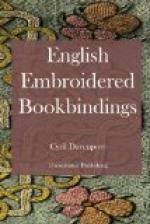Naturally, again, it may be sometimes difficult to decide whether a design should be classed as heraldic or floral. Such a difficulty occurs as to the large Bible at Oxford bound in red velvet for Queen Elizabeth, and bearing a design of Tudor and York roses. I consider it heraldic, but it might, with no less appropriateness, be called floral. If it had belonged to any one not a member of the Royal family it would undoubtedly be properly counted as a floral specimen. Again, in many of the portrait bindings flowers and arabesques are introduced, but they are clearly subordinate, and the chief decorative motive of such designs must be looked for, and the work classed accordingly. Thus it is evident that the arrangement of the embroidered books by their designs cannot be too rigidly applied, although it should not be lost sight of altogether.
Division of Embroidered Books according to the material on which they are worked.
A more useful and accurate classification may however be found by help of the material on which the embroidered work is done, and this division is obvious and easy. With very few exceptions all embroidered books, ancient and modern, are worked on canvas, velvet, or satin, and while canvas was used continuously from the fourteenth century until the middle of the seventeenth century, velvet was most largely used during the Tudor period, and satin during that of the early Stuarts.
Broadly speaking, the essential differences in the kind of work found upon these three materials follow the peculiarities of the materials themselves. Canvas, in itself of no decorative value, is always completely covered with needlework. Velvet, beautiful even when alone, but difficult to work upon, usually has a large proportion of applique, laid, or couched work, in coloured silk or satin, upon it, showing always large spaces unworked upon, and such actual work as occurs directly on the velvet is always in thick guimp or gold cord. Satin, equally beautiful in its way, is also freely left unornamented in places; the needlework directly upon it is often very fine and delicate in coloured floss silks, generally closely protected by thick raised frames or edges of metallic threads or fine gold or silver cords.
[Illustration: FIG. 1. Silken thread closely wound round with strip of flat metal.]
[Illustration: FIG. 2. Silken thread loosely wound round with strip of flat metal.]
[Illustration: FIG. 3. Strips of flat metal cut into shapes and kept down by small stitches at regular intervals. Called ‘Lizzarding.’]
By ‘metallic’ threads, when they are not simply fine wires, I mean strands of silk closely (Fig. 1) or loosely (Fig. 2) wound round with narrow coils of thin metal, mostly silver or silver gilt. The use of such threads, alone, or twisted into cords, is common on all styles of embroidered books, and it is largely due to their use that pieces of work apparently of the greatest delicacy are really extremely durable—far more so than is generally supposed. Certainly if it had not been for the efficient protection of these little metal walls we should not possess, as we actually do, delicate-looking embroidered books, hundreds of years old, in almost as good condition, except in the matter of colour, as when they were originally made.




